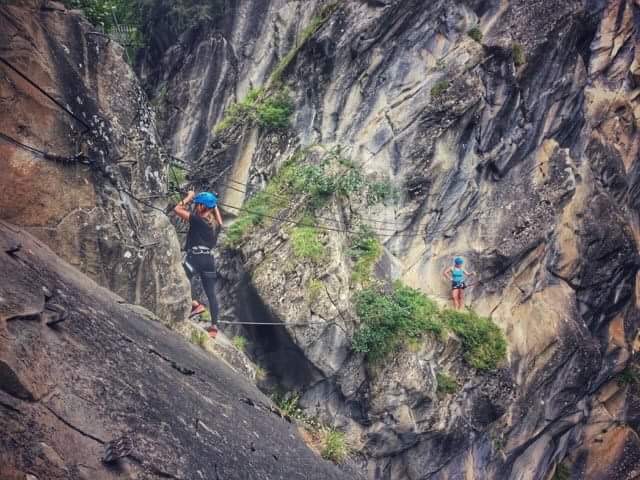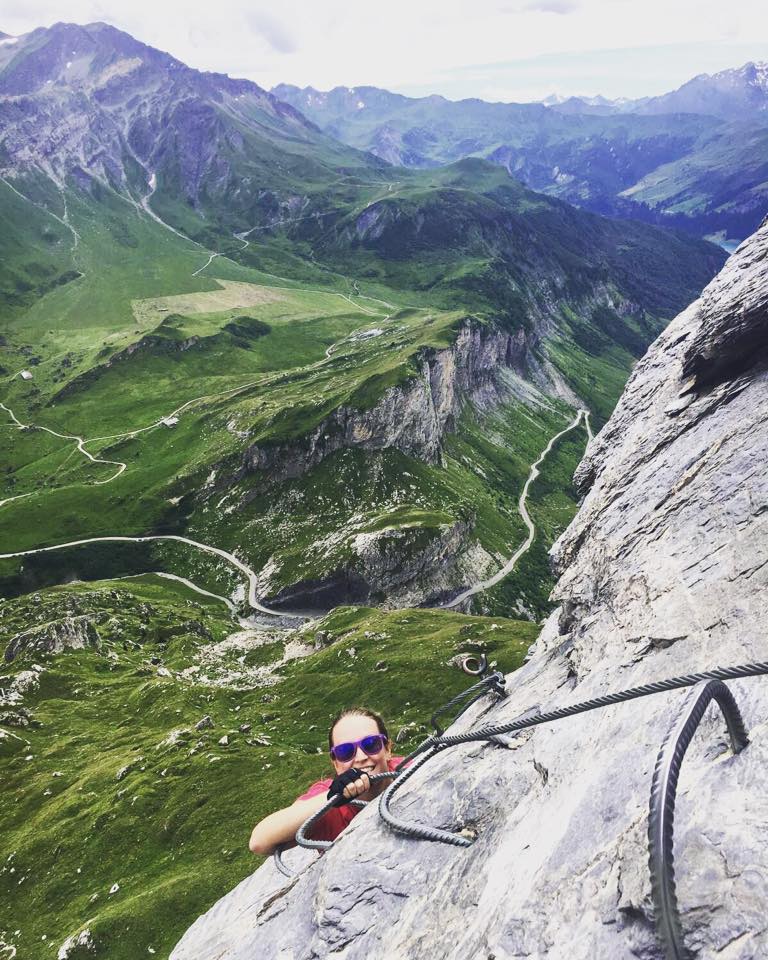Via Ferrata in The 3 Valleys
31st July 2019 | Things to do
If you own property in The French Alps and you haven’t heard of Via Ferrata then this is the blog you’ve been waiting for. Via Ferrata is essentially rock climbing but with the added security of bars and steps protruding from the mountain-side to guide you on your way.
via ferrata
/ˌviːə fəˈrɑːtə/
noun
a mountain route equipped with fixed ladders, cables, and bridges in order to be accessible to climbers and walkers.
Much like the picture above, it’s essentially a path designated for climbers, but without the extra layer of having to belay, lay your own line or shadow somebody else. This is particularly helpful if you’re just starting out on your climbing career. But that does not mean that it’s easy from start to finish, oh no no. Beginner Via Ferrata, such as the Lac Rosiere (details below) are perfect for beginners to try their hand. No experience necessary although of course we’d always recommend going with a guide if you’re new to the sport. Weave your way around the mountain on ladders, cables and wires whilst attached to the mountain by your harness and Via Ferrata kit.
The kit is essentially a climbing harness and two bungy cords with carabiners on the end, meaning that you’re always attached to something. Adding that extra layer of security (unless, like me, you never trust a harness!). Add a helmet and you’re ready to go! It’s worth noting that you can find yourself in some funny positions so if taking a backpack then make it small and certainly don’t leave anything in your pockets that you wouldn’t want to lose whilst on the monkey bridge!
If you’re starting out then you can always hire Via Ferrata equipment local to the sites (unless they’re remote sites, in which case you probably wouldn’t be attempting them as a beginner), and you can find guides here too. In all honesty, the equipment is not expensive. You can get a good, certified harness for €60-€100, and the Via Ferrata kit for €70 or even less in the sales. We’d recommend never buying second hand, as this stuff will save your life and you don’t know how the equipment has been kept previously. So if you get totally hooked on the sport then it’s well worth investing in the equipment.

As we mentioned before, make sure you start out easy and get a guide to learn the ropes (literally!). A few top tips can make your future experiences so much more enjoyable. And then only ever climb with people that you know and trust. Know your route, your exit points and your climbing buddy. If there’s been a very cold spell or it’s raining then probably avoid it as the metal and rock both get slippy. Weather can change extremely rapidly in the mountains so always make sure you’ve checked the forecast and are prepared, especially if on a route such as the top of Saulire which is very exposed.
On all of the Via Ferrata routes there are exit points, in case of emergency or wanting to avoid certain sections.
The Via Ferrata routes are graded as follows (using the French Mountaineering definitions):
F (Facile) – easy
PD (Peu Difficile) – a little bit difficult
AD (Assez Difficile) – difficult enough
D (Difficile) – difficult
TD (Tres Difficile) – very difficult
ED (Extrement Difficile) – extremely difficult
Look out for a + (plus) or – (minus) to, you guessed it, indicate where on the grade they sit.

In The 3 Valleys there are a few different routes that you can search out, some of which are in surrounding valleys:
PD – Lac Rosiere, Courchevel 1650
Length: 600m
Altitude at Start: 1550m
Altitude at Top: 1550m
This is a lovely little route which is great for beginners and (older) kids. Whilst it is quite a long route, due to the low grading it can be done fairly quickly, helped by the fact that you’re not gaining altitude. It winds around and then across the beautiful Lac Rosiere, which is nestled under the Dent du Villard (incidentally, this is also the start of the walk to the top of the DDV if you fancy another challenge). The route has great views without being too exposed or too high. Don’t get us wrong, it’ll still get your heart racing but that’s what we’re here for, right? As with all grading, there’s room for debate. I’d call this a F, but I think the swinging monkey bridge is probably what tips it into the PD category. Fabulous as there’s a little hut for drinks, ice creams and lunch and you can hire all the equipment.
D – Saulire – Courchevel/Méribel – La Croix des Verdons
Length : 800m
Altitude at Start: 1850m
Altitude at Top: 2739m
This is a biggy. First of all, personally I think this deserves a much higher rating than Pralognan, but again that’s where personal strength and ability comes into play. One of the reasons that this climb is so infamous is the sheer exposure. At the top of the Saulire mountain that joins Courchevel and Méribel sits this climb, and if you’re scared of exposed heights then I’d definitely be avoiding this one! It’s rocky and beautiful though, so definitely one for the bucket list.
D+ – Pralognan – La Cascade de la Fraîche
Length: 200m
Altitude at Start: 1500m
Altitude at Top: 1580m
As the name indicates, this stunning route crosses a huge waterfall. This can mean that when the waterfall is heavy you will GET WET! But it adds to the fun (just maybe avoid it after torrential storms). A bit more difficult but still not impossible if you’ve started to get your feet and into the swing of the climbing. Amazing views and a good length route if you’re looking for a new challenge.
ED+ – Champagny-en-Vanoise (La Plagne) – La via ferrata des grosses pierres
Length: 200m
Altitude at Start: 1290m
Altitude at Top: 1370m
Quite literally translating to the big stones, this one has jumped up on the grading as you can see. The difficulty in this one comes from it’s overhangs and narrow passages. People under 1m70 are advised that they may struggle to reach the bars, which is worth noting if you’re of the shorter variety. One thing to note on this path is that rock fall is not uncommon; another reason to be wearing that helmet!
Featured Image: © AD04
